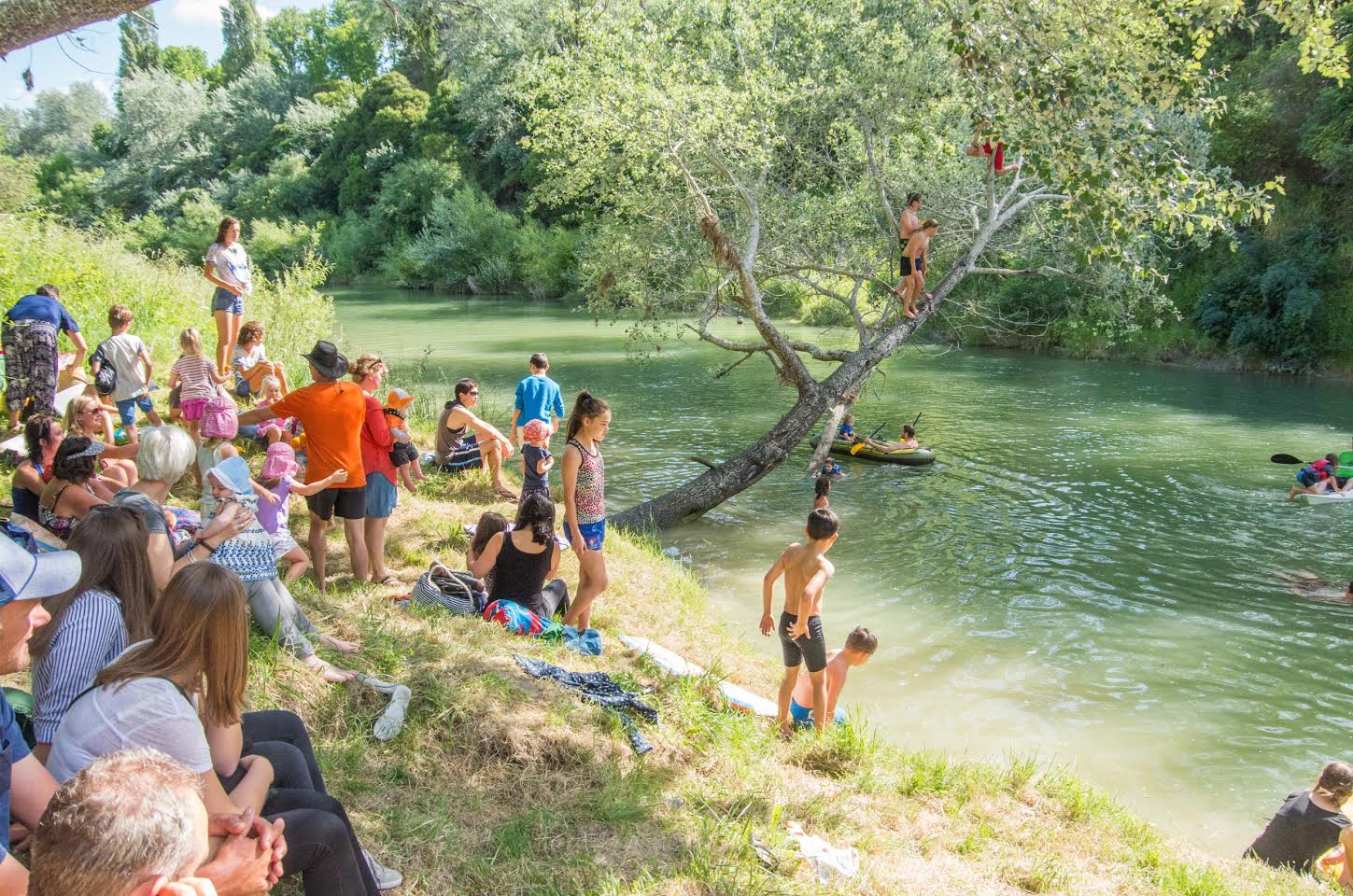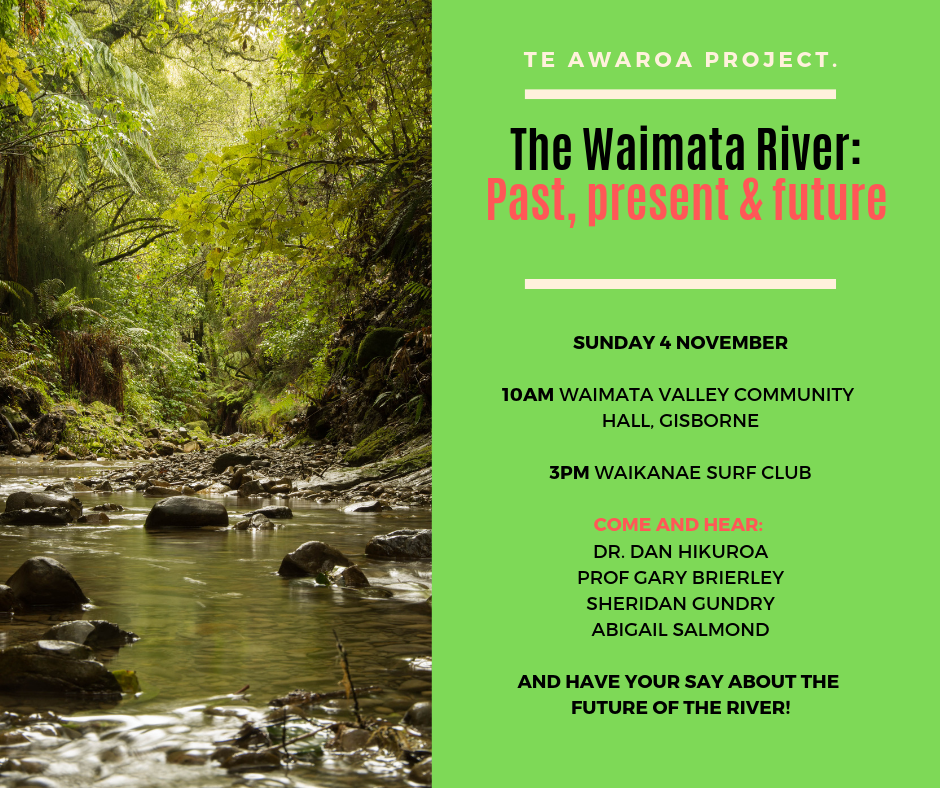Waimatā River
Waimatā River
The waters of the Waimatā run past the places where our shared history began. Fed by springs and streams, its headwaters rise in the hills north-east of Gisborne and run down to the city, with its harbour and port.
Opposite the Waikanae Stream, a sacred rock, Te Toka-a-Taiau (now underwater) marks the arrival of the voyaging canoes Horouta and Takitimu. At the river mouth, Captain James Cook and his companions stepped ashore in October 1769, the first Europeans to land in New Zealand.
Many people live on the banks of the Waimatā - farming families in the high country and urban dwellers in town. Its winding valley gives access by road to the hinterland, with its forests and farms.
Kayakers, rowers, waka ama paddlers, kids on rafts and fishers all use the river. In the city, the Waimatā and the Taraheru carved out the harbour on which the port, the marina, the fishing club and many cafes are built.

The Waimatā is in trouble
Today, the Waimatā is in trouble. Pastoral farming in steep, unstable country has led to severe erosion. Sediment flows into the river. The banks are grazed by stock in many places, leaving them bare of bush cover. When it rains, the river turns to liquid mud.
In the headwaters, exotic forests planted to protect the hills are being clear felled. Tracks scar the ridges, and when it rains heavily, piles of slash (logging debris) and bark wash down the slopes. With no bush buffers, sediment and debris are swept into the streams, down the river into the harbour, and onto the beaches. Sediment clogs the port and local fisheries.
See Ian Ruru’s eloquent video about the Waimatā, ‘A River in Tears’.
The tide is turning
The tide is turning. International markets for timber, meat and wool now demand products that meet high environmental standards.
The Forestry Stewardship Council requires bush buffers around waterways in forests, and 10% of each forest to be devoted to native species. Foresters who breach these standards risk losing their access to world markets.
Around New Zealand, people no longer take their rivers for granted. In many places, foresters, farmers, local bodies and residents are joining together to protect their waterways.
The Future of the Waimatā
Many people live beside the Waimatā river, use it, or cross it every day. Surf life savers, surfers, paddlers, sailors, fishers and walkers all want to see forestry debris and logs removed from the river, the sea and the beaches.
In the headwaters, large areas are controlled by a few forestry companies that belong to the Forestry Stewardship Council, with its high environmental standards.
The port has a commercial interest in reducing sediment loadings in the river, and its dredging bills. Ratepayers and the Council will benefit if repair bills for roads and other infrastructure damaged by flooding can be limited.
Te Awaroa
At the 2012 Transit of Venus Forum in Gisborne, our Chairperson came up with the idea of Te Awaroa, a project to take care of waterways across New Zealand. This would restore integrity to our 100% Pure New Zealand brand, create wildlife corridors for endangered species and cleanse the water, enhancing the beauty of our rivers for kayakers, swimmers, paddlers, rowers and fishers.
Watch Dan Hikuroa talk about Te Awaroa, or read the Strategic Plan for more information on this project.
Guardians of the Waimatā
The Te Awaroa team have conducted a case study of the Waimatā River, producing reports on its geomorphology, Maori and settler histories, and the ecology of the from the mountains to the sea (See report on the ecology of the Waimatā).
The next stage is to share these insights into the past and present of the Waimatā River with the community, and seek to ensure that it returns to a state of ora (well-being, abundance).

Waimatā Catchment Restoration Inc. established
In July 2020, after another workshop was held at the Waimatā River Valley Hall, Waimatā Catchment Restoration Inc. was set up, and officers elected.
The Waimatā River restoration project is now in full swing, supported by a $500,000 grant from the Erosion Control funding. This pilot project is funding fencing and planting on 7 properties, and farm environment plans for all farms in the catchment.
Waimatā Catchment Restoration Inc. now has its own Facebook page, where you can keep in touch with the project as it progresses.
Let the River Speak
Ko au te awa, ko te awa ko au. Kei te mate te awa, kei te mate ahau.
I am the river, and the river is me. If the river is dying, so am I.
This Marsden research project, led by Principal Investigators Dame Anne Salmond and Dr. Dan Hikuroa at the University of Auckland, builds on New Zealand legislation which, for the first time in the world, recognises a river as having its own life and rights.
In this research, the Waimatā is regarded as a living community of land, water, plants, animals and people. We aim to explore the life of this river community through time, from its beginnings about 1 million years ago to the present, examining its dynamics and working with others to restore it to a state of ora - health, well being and flourishing.
At present, the Waimatā river community faces many challenges, including past land use decisions, climate change and biodiversity losses.
The river, which is tightly constrained by its terraces, acts like a chute. In severe rain events, rafts of forestry slash, logs and trees surge down steep, highly erodible hillsides, carving out gullies and choking the river with sediment.
As they are swept down river, the rafts jam on bridges and steep corners, creating dams and mini-tsunamis when the dams burst, destroying river banks, roads, bridges, fences, paddocks, orchards, farm buildings and homes.
During these flood events, sewage and wastewater are released into the Waimatā, making it toxic for freshwater species and people. As slash and sediment are deposited on the bed of the river, it is rising, threatening Gisborne city, which is built on a flood plain.
In response to these challenges, the ‘Let the River Speak’ research team are studying the geology, geomorphology, hydrology, ecology, human history and social life of the Waimatā river, drawing upon mātauranga as well as cutting edge science to understand its dynamics. We aim to work with local people on planning for flood resilience, sustainable land use and the restoration of riparian forests and wetlands in the catchment, so that the Waimatā river community can flourish and thrive.
- Marsden Fund Full Research Proposal: Let the River Speak
- The Root of the Matter: Forests & Colonial Histories in Aotearoa New Zealand - Anne Salmond, Manu Caddie
Waimatā River Resources
Research Reports
- Research Report 1 (Landscapes and Rivers of the Waimatā)
- Research Report 2 (Native Land Court Records of Blocks on the Waimatā)
- Research Report 3 (Settler History post 1880)
- Research Report 4 (Biodiversity in the Waimatā)
- Research Report 5 (A Place Belonging to the Heart)
- Ecological impacts and planning history - An environmental history of the Turanganui-a-Kiwa casebook area - Dr. Brad Coombes
- The Turanganui River - A Brief History - Michael Spedding
Articles
- 2008: Last Glacial Aggradation and Postglacial Sediment Production from the Non-Glacial Waipaoa and Waimata Catchments, Hikurangi Margin, North Island, New Zealand - Marden, Michael et al.
- 2016: An Approach for Measuring Confinement and Assessing the Influence of Valley Setting on River Forms and Processes. - Fryirs, Kirstie A. et al.
- 2018: “Engineering Geomorphological Reconnaissance of the December 2018 Waimata Valley Mud Volcano Eruption, Gisborne, New Zealand. - Leighton, Alex et al.
- 2019: Let the Rivers Speak - Thinking about waterways in Aotearoa New Zealand - Anne Salmond, Gary Brierley and Dan Hikuroa
- 2020: Rivers, residents, and restoration: Local relations to the Waimatā River, Aotearoa New Zealand - Danielle Cairns, Gary Brierley, and Gretel Boswijk
- 2021: Steps towards incorporating geomorphic considerations in farm and catchment management plans in the Waimatā Catchment, Aotearoa New Zealand - Harvey, Brierley, Easton, Watson, Tunnicliffe
- 2022: Tai Timu, Tai Pari, the Ebb and Flow of the Tides: Working with the Waimatā from the Mountains to the Sea Salmond, Anne et al.
- 2023: Managing at source and at scale: The use of geomorphic river stories to support rehabilitation of Anthropocene riverscapes in the East Coast Region of Aotearoa New Zealand - Fuller, I. C. et al.
Resources
- Sheridan Gundry’s short illustrated account of the Waimatā River (Please don’t copy the images)
- Waimatā Catchment Map with blocks and ancestral place names, by Hamish MacDonald
- Waimatā Catchment Restoration Project on Facebook
Theses
- 2020: Engineering geological investigation of a recent mud volcano eruption, Waimata Valley - Leighton, Alex
- 2021: Integrating Process-Based Assessments of River Sensitivity through River Styles and Semi-Quantitative Sediment Connectivity Modelling to Inform Land Use Management in the Waimatā Catchment, Gisborne, New Zealand - Harvey, Khendra Claire
- 2021: Rivers, residents and restoration : Local relations to the Waimatā River, Aotearoa New Zealand - Cairns, Danielle
- 2022: An exploration of the potential role of storytelling in development of catchment management plans (CMPs) - Stevens, Elliot
- 2023: Hydrological Responses to Differing Land Cover Scenarios to Better Inform Farm and Catchment Planning Initiatives for the Waimatā River, Gisborne, New Zealand - Burgess, Jazmine
Funding Applications
- Marsden Fund Full Research Proposal: Let the River Speak
- Waimatā River Restoration Project (Supporting document)

